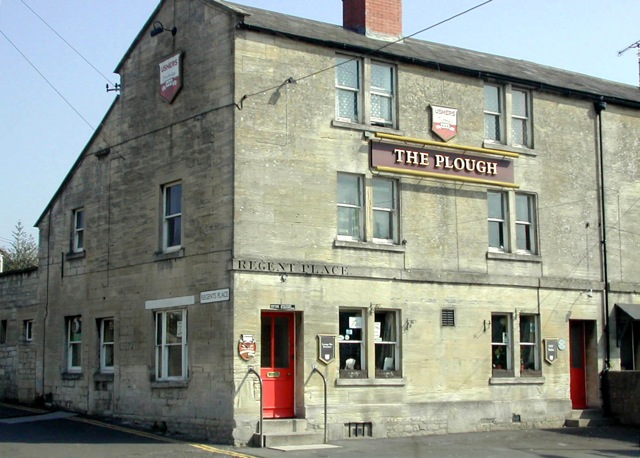.
Public Houses, Inns and Hotels
Bradford on Avon Town, Wiltshire
.
.
Public houses come and go over the centuries; unfortunately, at the moment it is mostly go. They also have a habit of changing their names at the whim of the owner or publican, which sometimes makes for a confusing historical record.
.
St Margaret’s Street
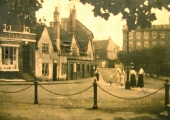 The Queen’s Head was mentioned in 1737. It became the property of G. & T. Spencer’s Bradford brewery in 1897, which was closed down in 1914 when it was taken over by Usher’s of Trowbridge. The Queen’s Head closed also as part of Usher’s rationalisation. In 1931 butcher Bert Scrine and Co-op confectioner Edie Baxter turned it into the Three Gables café after they had married. The building meanwhile had been restored, with 17th century-style mullioned windows replacing horizontal sashes.
The Queen’s Head was mentioned in 1737. It became the property of G. & T. Spencer’s Bradford brewery in 1897, which was closed down in 1914 when it was taken over by Usher’s of Trowbridge. The Queen’s Head closed also as part of Usher’s rationalisation. In 1931 butcher Bert Scrine and Co-op confectioner Edie Baxter turned it into the Three Gables café after they had married. The building meanwhile had been restored, with 17th century-style mullioned windows replacing horizontal sashes.
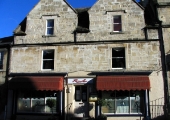 Originally one 17th century house, this became two in c1700. In the late 18th century and first half of the 19th, the left side was The French Horn public house. Later this half was the Midland Railway’s office. In the 20th century the two halves were reunited and were Bryant’s hardware shop for many years. It is now the Thai Barn restaurant.
Originally one 17th century house, this became two in c1700. In the late 18th century and first half of the 19th, the left side was The French Horn public house. Later this half was the Midland Railway’s office. In the 20th century the two halves were reunited and were Bryant’s hardware shop for many years. It is now the Thai Barn restaurant.
.
 Timbrell’s Yard is in a building of the beginning of the 18th century that was known for much of its life as St Margaret’s House. Its history was intricately related to the wool dye works next door, including today’s St Margaret’s Hall, until they closed in 1905. It became the Conservative Club, then the Rowing Club with addition of a gymnasium and the Riverside pub in 1985. Despite converting part to a hotel and adding another function room, it closed in 2013. It was refurbished and reopened in 2015 and named after the Museum’s painting.
Timbrell’s Yard is in a building of the beginning of the 18th century that was known for much of its life as St Margaret’s House. Its history was intricately related to the wool dye works next door, including today’s St Margaret’s Hall, until they closed in 1905. It became the Conservative Club, then the Rowing Club with addition of a gymnasium and the Riverside pub in 1985. Despite converting part to a hotel and adding another function room, it closed in 2013. It was refurbished and reopened in 2015 and named after the Museum’s painting.
In 1808 James Mead of The Fisherman in St Margaret’s Hill was subject to the Poor Rate. It might have been what is known as Morgan’s Lodge at number 8. It doesn’t seem to have been mentioned again and Mead was running the Green Dragon in Silver Street by 1823. Another in this area with a brief mention, perhaps the same under a different name, was The Greyhound.
.
Frome Road
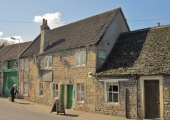 The Three Horseshoes claims to date from 1685. It certainly is a 17th century building, with extensions. Externally it is little changed from a photograph of the late 19th century, but the small rooms of the interior were knocked through in the early 1980s. In 1864 it belonged to the Wilkins Brothers’ brewery in Newtown, which was bought by Usher’s of Trowbridge.
The Three Horseshoes claims to date from 1685. It certainly is a 17th century building, with extensions. Externally it is little changed from a photograph of the late 19th century, but the small rooms of the interior were knocked through in the early 1980s. In 1864 it belonged to the Wilkins Brothers’ brewery in Newtown, which was bought by Usher’s of Trowbridge.
.
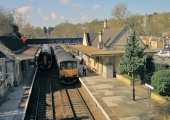 The cutting in which Bradford’s railway station stands is the site of The Cross Keys public house. In the late 18th century it was run by Richard Pearce, friend and supporter of John Wesley, the founder of the Methodists. Methodist meetings were held in a room behind the bar. In 1846 there were two parlour bars and tap room on the ground floor, ten rooms above and cellar below and a courtyard with kitchen and stable. It was demolished to make way for the railway in 1847.
The cutting in which Bradford’s railway station stands is the site of The Cross Keys public house. In the late 18th century it was run by Richard Pearce, friend and supporter of John Wesley, the founder of the Methodists. Methodist meetings were held in a room behind the bar. In 1846 there were two parlour bars and tap room on the ground floor, ten rooms above and cellar below and a courtyard with kitchen and stable. It was demolished to make way for the railway in 1847.
.
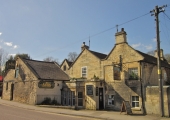 The Canal Tavern is next to the lower wharf and the bridge over the Kennet & Avon Canal. It had not been built in 1838, but had appeared by the time of the 1851 Census. It belongs to the Wadworth brewery of Devizes.
The Canal Tavern is next to the lower wharf and the bridge over the Kennet & Avon Canal. It had not been built in 1838, but had appeared by the time of the 1851 Census. It belongs to the Wadworth brewery of Devizes.
.
.
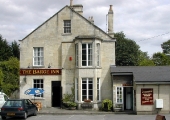 The Barge Inn, across the canal bridge and next to the upper wharf has the look of a warehouse with later extensions and may incorporate the former Clay Farm house that was there before the canal. It had opened by 1826 and must have catered to the people who were travelling on the canal barges, with lodging for some of them. Nearby there were also underground stone quarries that became mushroom farms, a large canal-side malthouse and a timber yard.
The Barge Inn, across the canal bridge and next to the upper wharf has the look of a warehouse with later extensions and may incorporate the former Clay Farm house that was there before the canal. It had opened by 1826 and must have catered to the people who were travelling on the canal barges, with lodging for some of them. Nearby there were also underground stone quarries that became mushroom farms, a large canal-side malthouse and a timber yard.
Trowbridge Road
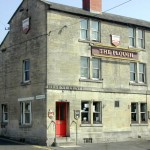 The Plough, on the corner of Regent’s Place, looks as if it may have started as two houses, presumably at the time of the Regency in the first two decades of the 19th century. It was operating as a pub by 1841.
The Plough, on the corner of Regent’s Place, looks as if it may have started as two houses, presumably at the time of the Regency in the first two decades of the 19th century. It was operating as a pub by 1841.
.
.
.
.
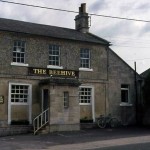 Just before the canal bridge at Widbrook is The Beehive. There was just pasture here in 1841, but Jesse Morrell was a beer retailer at “Whitbrook” in 1859. It traded as The New Inn until around the beginning of the First World War, when it had ceased to be so new. It had mixed fortunes in the late 20th century and closed in 2009, following a bankruptcy. Change of use was opposed, but it seems unlikely to reopen.
Just before the canal bridge at Widbrook is The Beehive. There was just pasture here in 1841, but Jesse Morrell was a beer retailer at “Whitbrook” in 1859. It traded as The New Inn until around the beginning of the First World War, when it had ceased to be so new. It had mixed fortunes in the late 20th century and closed in 2009, following a bankruptcy. Change of use was opposed, but it seems unlikely to reopen.
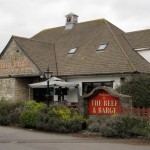 Across the canal at Widbrook is The Beef and Barge (previously The Millhouse, before that The Gongoozler), a restaurant/bar complex that was erected in about 1988 as part of the development of the marina. It was closed in December 2013 and reopened in 2014 under yet another name- The Boathouse.
Across the canal at Widbrook is The Beef and Barge (previously The Millhouse, before that The Gongoozler), a restaurant/bar complex that was erected in about 1988 as part of the development of the marina. It was closed in December 2013 and reopened in 2014 under yet another name- The Boathouse.
.
.
.
Silver Street
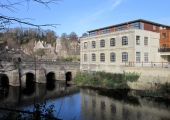 The former rubber industry building next to the Town Bridge occupies the site of the old Lamb Inn and was known as the Lamb Factory; Lamb Yard also takes its name from the inn. The Lamb was a Georgian building with a large sculpture of a lamb above the door. As part of the Spencer brewery’s property, it was taken over by Usher’s in 1914 and closed. Three years later the Spencer Moulton rubber company owned it and replaced it and a house next to the river with the factory, which now has been converted to other uses.
The former rubber industry building next to the Town Bridge occupies the site of the old Lamb Inn and was known as the Lamb Factory; Lamb Yard also takes its name from the inn. The Lamb was a Georgian building with a large sculpture of a lamb above the door. As part of the Spencer brewery’s property, it was taken over by Usher’s in 1914 and closed. Three years later the Spencer Moulton rubber company owned it and replaced it and a house next to the river with the factory, which now has been converted to other uses.
A public house called The Scribbling Horse, named after a piece of wool-working equipment, “near the bridge” was advertised for sale in 1783 and was listed in 1822. This seems to have been the previous name for the Lamb.
There was, briefly, another pub nearby which went under the name of The Queen Victoria for a few years after Victoria’s accession in 1837.
Number 34 Silver Street, currently a teashop, was the site of The Green Dragon between 1773 and 1841. This building was large enough to have “a commodious room upwards of sixty feet long” where furniture from Cumberwell House was auctioned in 1776 and “in which seats will be compleatly fitted up for the company“.
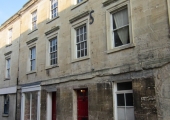 Just into Kingston Road was The Rose & Crown public house. It was a gabled building of the late 17th century and was recorded as a going concern in 1763, but was closed down in 1907 and then demolished c1960 to make way for Avon rubber company offices. In the 1890s, the publican Henry Mead combined the pub with a business as a boot maker.
Just into Kingston Road was The Rose & Crown public house. It was a gabled building of the late 17th century and was recorded as a going concern in 1763, but was closed down in 1907 and then demolished c1960 to make way for Avon rubber company offices. In the 1890s, the publican Henry Mead combined the pub with a business as a boot maker.
.
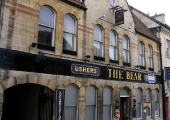 The Bear Inn probably became The Old Bear in the 19th century when the New Bear opened on the opposite side of Silver Street. The present façade, with its stripes of red Mansfield Stone contrasting with the Bath Stone ashlar, dates from a rebuilding of the 1880s in order to widen a bottleneck in the road. It closed in 2023 and it is likely to be permanent.
The Bear Inn probably became The Old Bear in the 19th century when the New Bear opened on the opposite side of Silver Street. The present façade, with its stripes of red Mansfield Stone contrasting with the Bath Stone ashlar, dates from a rebuilding of the 1880s in order to widen a bottleneck in the road. It closed in 2023 and it is likely to be permanent.
.
.
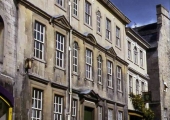 The large early 18th century building now called Silver Street House was formerly The Angel. For some reason, it was renamed The New Bear and was really more of a hotel than a public house. Rooms in the building were used by local clubs and societies for their meetings. It closed in 1958, was divided into flats and became somewhat derelict, until rescued by Bradford on Avon Preservation Trust in 1979.
The large early 18th century building now called Silver Street House was formerly The Angel. For some reason, it was renamed The New Bear and was really more of a hotel than a public house. Rooms in the building were used by local clubs and societies for their meetings. It closed in 1958, was divided into flats and became somewhat derelict, until rescued by Bradford on Avon Preservation Trust in 1979.
.
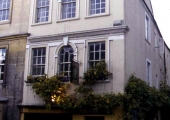 Next to Silver Street House is The Bunch of Grapes public house, once with a large grape vine growing on its walls. These were the premises of Thomas & Emanuel Taylor, druggists, from the late 18th century and was known as the Bunch of Grapes by 1846. The Taylors gradually turned over to be wine and spirit merchants, formerly a sideline, expanding to a new building across the road in the 1880s. It closed after the sudden departure of its publican after just a few days in 2013, but re-opened in November 2015.
Next to Silver Street House is The Bunch of Grapes public house, once with a large grape vine growing on its walls. These were the premises of Thomas & Emanuel Taylor, druggists, from the late 18th century and was known as the Bunch of Grapes by 1846. The Taylors gradually turned over to be wine and spirit merchants, formerly a sideline, expanding to a new building across the road in the 1880s. It closed after the sudden departure of its publican after just a few days in 2013, but re-opened in November 2015.
.
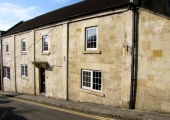 Up White Hill, which begins where Silver Street becomes Woolley Street, lies the building that was formerly The King’s Head public House. It was recorded in 1830 and closed in about 1961.
Up White Hill, which begins where Silver Street becomes Woolley Street, lies the building that was formerly The King’s Head public House. It was recorded in 1830 and closed in about 1961.
.
.
.
 The last house on the east side is called The Old House. It was briefly the New Inn in the early 18th century and was given a new Georgian façade later in the century. It has a five-bay, two-storey and attic frontage on to the street, with elaborate ironwork railings up to the door. On the left Mill Lane leads down to Kingston Road. A member of the Taylor family, Edward, had a rope, twine and canvas business here and the Ropewalk, Newtown.
The last house on the east side is called The Old House. It was briefly the New Inn in the early 18th century and was given a new Georgian façade later in the century. It has a five-bay, two-storey and attic frontage on to the street, with elaborate ironwork railings up to the door. On the left Mill Lane leads down to Kingston Road. A member of the Taylor family, Edward, had a rope, twine and canvas business here and the Ropewalk, Newtown.
The Shambles
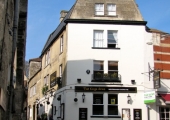 At the corner of the Shambles and Coppice Hill, The King’s Arms would have faced the market hall (demolished in the 1820s) and old market place. It has apparently had various names, however was the King’s Arms in 1726. Another name change came in 1995, when the Magic Pub Company (bought by Greene King in 1996) called it The Sprat & Carrot. In 2011, after an attempt at being a gastro-pub, it became more of an Indian restaurant than a pub, under the name King’s Spice, but this has now closed.
At the corner of the Shambles and Coppice Hill, The King’s Arms would have faced the market hall (demolished in the 1820s) and old market place. It has apparently had various names, however was the King’s Arms in 1726. Another name change came in 1995, when the Magic Pub Company (bought by Greene King in 1996) called it The Sprat & Carrot. In 2011, after an attempt at being a gastro-pub, it became more of an Indian restaurant than a pub, under the name King’s Spice, but this has now closed.
.
 The building with a 15th century doorway at the Silver Street end of the Shambles was The Royal Oak Inn from at least 1792, but the name became popular after the Restoration in 1660. It is one of those pubs that closed at the beginning of the 20th century. It was Tillion’s shop, having previously been the electricity board’s showroom.
The building with a 15th century doorway at the Silver Street end of the Shambles was The Royal Oak Inn from at least 1792, but the name became popular after the Restoration in 1660. It is one of those pubs that closed at the beginning of the 20th century. It was Tillion’s shop, having previously been the electricity board’s showroom.
.
.
Market Street
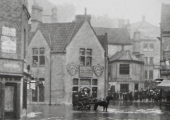 At the bottom of Horse Street, the lower part of the present Market Street, was The White Hart Inn. It was recorded in 1731, but the building in the 1903 photograph was of the late 19th century. It was sold in 1865 as an inn and brewery, but rebuilt by Rev J.C. Thring as a “coffee tavern” a temperance hotel and restaurant. Around 1907 the hardware company H.J. Knee converted it into a shop with plate glass windows, but it was demolished for road improvement in the 1960s and the space is still known as Knee’s Corner.
At the bottom of Horse Street, the lower part of the present Market Street, was The White Hart Inn. It was recorded in 1731, but the building in the 1903 photograph was of the late 19th century. It was sold in 1865 as an inn and brewery, but rebuilt by Rev J.C. Thring as a “coffee tavern” a temperance hotel and restaurant. Around 1907 the hardware company H.J. Knee converted it into a shop with plate glass windows, but it was demolished for road improvement in the 1960s and the space is still known as Knee’s Corner.
There was a mention in the Bath Chronicle newspaper of a Golden Lion in Horse Street in 1771, but the building is not known.
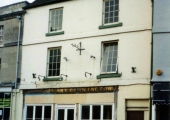 The Dandy Lion opened as recently as 1990. In the 19th century it had been the shop of corn chandler and grocer Thomas Smart. Later in the same century it was Albert Nichols’ grocery, becoming Nichols & Bushell Ltd, which is remembered by many older residents. In the 1970s it changed into the New Shandon Steakhouse and in the following decade became a bistro-style pub under the name of The Ancient Fowl. Brewers Wadworth bought it in 1990 and refitted it as The Dandy Lion.
The Dandy Lion opened as recently as 1990. In the 19th century it had been the shop of corn chandler and grocer Thomas Smart. Later in the same century it was Albert Nichols’ grocery, becoming Nichols & Bushell Ltd, which is remembered by many older residents. In the 1970s it changed into the New Shandon Steakhouse and in the following decade became a bistro-style pub under the name of The Ancient Fowl. Brewers Wadworth bought it in 1990 and refitted it as The Dandy Lion.
.
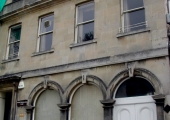 A public house named The Maiden Head Inn with brewery was mentioned in 1611. The building that is now the Town Club was probably put up after Richard Pearce bought it in 1755. Pearce built a Methodist Chapel and priest’s lodging on the back for use by John and Charles Wesley and other preachers. By the 19th century it was used by a draper, then by the Rawlings, printers. It was the Conservative Club from 1903 and the Town Club from 1925. In October 2017 part of it became a pub again- The Stumble Inn.
A public house named The Maiden Head Inn with brewery was mentioned in 1611. The building that is now the Town Club was probably put up after Richard Pearce bought it in 1755. Pearce built a Methodist Chapel and priest’s lodging on the back for use by John and Charles Wesley and other preachers. By the 19th century it was used by a draper, then by the Rawlings, printers. It was the Conservative Club from 1903 and the Town Club from 1925. In October 2017 part of it became a pub again- The Stumble Inn.
.
Church Street
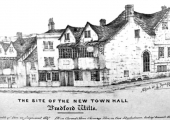 On the corner of Market Street and Church Street, in a building that was dated 1687, was a pub called The Hare. This seems to have changed its name to The New Market Tavern in the middle of the 19th century, after the market was moved here from the Old Market Place, Silver Street. However, in 1854 this whole block of buildings was demolished to make way for the new Town Hall.
On the corner of Market Street and Church Street, in a building that was dated 1687, was a pub called The Hare. This seems to have changed its name to The New Market Tavern in the middle of the 19th century, after the market was moved here from the Old Market Place, Silver Street. However, in 1854 this whole block of buildings was demolished to make way for the new Town Hall.
.
.
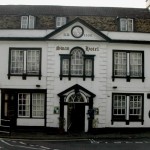 The Swan Hotel is at the heart of the town, at the junction of Church Street and Market Street, opposite the old Town Hall. It is a Georgian building with a pedimented section at the middle of the façade over a ‘venetian’ window. It bears the date 1500, but there is nothing about it that looks to be of that date. It closed and put up for sale in 2023. Read more
The Swan Hotel is at the heart of the town, at the junction of Church Street and Market Street, opposite the old Town Hall. It is a Georgian building with a pedimented section at the middle of the façade over a ‘venetian’ window. It bears the date 1500, but there is nothing about it that looks to be of that date. It closed and put up for sale in 2023. Read more
.
.
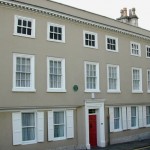 Next door to The Swan is a building that was mentioned in 1723 as having been “formerly The Red Lyon“. It was let to clothier John Moggridge in 1767 and sold to him in 1794. He built a woollen cloth factory on land to the rear. It is now called Old Bank House because the Wilts & Dorset Banking Company had its branch here before getting premises in the former Town Hall.
Next door to The Swan is a building that was mentioned in 1723 as having been “formerly The Red Lyon“. It was let to clothier John Moggridge in 1767 and sold to him in 1794. He built a woollen cloth factory on land to the rear. It is now called Old Bank House because the Wilts & Dorset Banking Company had its branch here before getting premises in the former Town Hall.
.
.
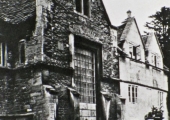 The small garden next to the Church Hall (Freemasons’ Hall) is the site of of a late 17th century building that was a pub that was named as The Ship in 1777, but called The Carpenters’ Arms from about 1850. The last record is in the 1871 Census, after which it became a private house. The building existed until about 1920, but it had gone by 1924. It can just be seen in a photograph of the Church Hall in about 1905.
The small garden next to the Church Hall (Freemasons’ Hall) is the site of of a late 17th century building that was a pub that was named as The Ship in 1777, but called The Carpenters’ Arms from about 1850. The last record is in the 1871 Census, after which it became a private house. The building existed until about 1920, but it had gone by 1924. It can just be seen in a photograph of the Church Hall in about 1905.
.
Newtown
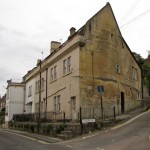 There were once four public houses, a major brewery and several shops on Newtown; now there is none. At the foot of Conigre Hill was The Bell, a sizable pub with a small brewery behind. The building bears the date 1695, but this stone must have been reused when it was rebuilt a century later. It still has a wrought iron bracket from which hung its sign in the shape of a bell; brackets of this pattern were also on The Royal Oak and The Swan. The Bell closed soon after 1965.
There were once four public houses, a major brewery and several shops on Newtown; now there is none. At the foot of Conigre Hill was The Bell, a sizable pub with a small brewery behind. The building bears the date 1695, but this stone must have been reused when it was rebuilt a century later. It still has a wrought iron bracket from which hung its sign in the shape of a bell; brackets of this pattern were also on The Royal Oak and The Swan. The Bell closed soon after 1965.
.
.
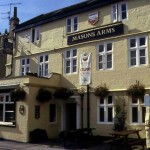 The Masons’ Arms was known to locals as “the middle house” because it was between The Bell and The Seven Stars, even long after those two had closed. The building dates from the end of the 17th century, but the bar was extended in a single storey towards the street in the 19th century. When it closed, the last Newtown pub to do so, change of use was opposed, but no buyer was found and it has been converted to housing. The sign is still there, as is an etched glass window in the extension.
The Masons’ Arms was known to locals as “the middle house” because it was between The Bell and The Seven Stars, even long after those two had closed. The building dates from the end of the 17th century, but the bar was extended in a single storey towards the street in the 19th century. When it closed, the last Newtown pub to do so, change of use was opposed, but no buyer was found and it has been converted to housing. The sign is still there, as is an etched glass window in the extension.
.
.
 The first Newtown pub to close was The White Lion, the right hand part of the building in the photograph. It was recorded in 1765 and publicans over the next century came from several licenced victualler families: Spenders, Mundy and Gerrish. The Lodge of Unity & Friendship of the Freemasons met here from 1817 to 1832. The last record we have is from 1865.
The first Newtown pub to close was The White Lion, the right hand part of the building in the photograph. It was recorded in 1765 and publicans over the next century came from several licenced victualler families: Spenders, Mundy and Gerrish. The Lodge of Unity & Friendship of the Freemasons met here from 1817 to 1832. The last record we have is from 1865.
.
.
.
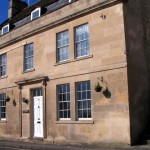 Across the junction with Wine Street is the former Seven Stars. It existed in 1722, but the present building dates from much later in the 18th century. The Merrick, Sandell and Wilkins families developed a malthouse and brewery around the pub, expanding as Wilkins Brothers into an old quarry beyond Wine Street. The brewery closed early in the 20th century, but the pub went on until about 1968.
Across the junction with Wine Street is the former Seven Stars. It existed in 1722, but the present building dates from much later in the 18th century. The Merrick, Sandell and Wilkins families developed a malthouse and brewery around the pub, expanding as Wilkins Brothers into an old quarry beyond Wine Street. The brewery closed early in the 20th century, but the pub went on until about 1968.
.
.
.
Northern fringes
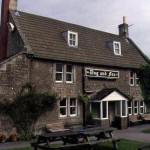 At the point where Ashley Road suddenly becomes a country lane is The Dog & Fox. In 1841 it was three houses, but had become a public house by 1879. Apart from a gap of 18 months, it was run by the same family from 1958 to 2011.
At the point where Ashley Road suddenly becomes a country lane is The Dog & Fox. In 1841 it was three houses, but had become a public house by 1879. Apart from a gap of 18 months, it was run by the same family from 1958 to 2011.
.
.
.
.
 The Rising Sun in Winsley Road (previously Church Lane) was in the hands of the Blackmore family, who owned several houses in the Bearfield area, from about 1840 until the 1870s. Frank “Dodger” Mayell was the publican here for fifty years, from the First World War until the 1950s.
The Rising Sun in Winsley Road (previously Church Lane) was in the hands of the Blackmore family, who owned several houses in the Bearfield area, from about 1840 until the 1870s. Frank “Dodger” Mayell was the publican here for fifty years, from the First World War until the 1950s.
.
.
.
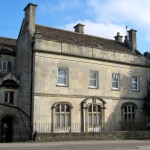 Next to Christ Church in Bath Road was The New Inn, which was recorded between 1826 and 1865. It became a large private house and, late in the 19th century was given new ground floor windows and other features. It is now called Clifton House.
Next to Christ Church in Bath Road was The New Inn, which was recorded between 1826 and 1865. It became a large private house and, late in the 19th century was given new ground floor windows and other features. It is now called Clifton House.
.
.
.
.
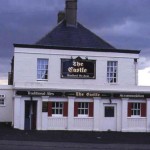 The Castle, Mount Pleasant, at the top of Masons Lane may have started as a Georgian house with wonderful views over the town and countryside, but had became a public house by 1848.
The Castle, Mount Pleasant, at the top of Masons Lane may have started as a Georgian house with wonderful views over the town and countryside, but had became a public house by 1848.
.
.
.
.
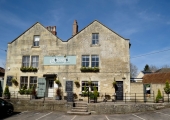 Out to the north-east in the hamlet of Woolley is The George public house. It was three houses in 1841, but had become a pub by 1879 and was owned by Frome United Breweries in 1889. It closed in 2014, but was registered as a Community Asset and reopened in July 2015 under former incumbents of the Tollgate Inn, Holt.
Out to the north-east in the hamlet of Woolley is The George public house. It was three houses in 1841, but had become a pub by 1879 and was owned by Frome United Breweries in 1889. It closed in 2014, but was registered as a Community Asset and reopened in July 2015 under former incumbents of the Tollgate Inn, Holt.
.
.
Crown Court, the group of cottages opposite, is named after The Crown, a disappeared pub that was recorded between 1837 and 1879. Late 18th-early 19th century deeds suggest that there was once a pub called The King’s Head in Woolley.
.


